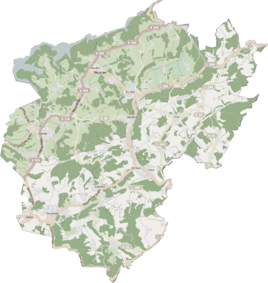Engeldorf
|
Engeldorf
Kurten municipality
Coordinates: 50 ° 59 ′ 57 ″ N , 7 ° 15 ′ 11 ″ E
|
||
|---|---|---|
| Height : | 215 m above sea level NN | |
| Postal code : | 51515 | |
|
Location of Engeldorf in Kürten |
||
|
View of Engeldorf 2016
|
||
Engeldorf is a district of the municipality of Kürten in the Rheinisch-Bergisches Kreis . Engeldorf is also the name of a district in the municipality of Kürten.
Location and description
Engeldorf is on the way from Biesfeld to Offermannsheide . Johann Fischer lived here , whose angel collection was the original equipment for the First German Angel Museum in Engelskirchen .
Etymology and history
Engeldorf was first mentioned in a document in 1074. The determinant angel is probably derived from a personal name Angilo or Engil .
According to another, not strictly philological interpretation of the local history association, Engeldorf is a condemnation of the dialectal op dr Engeped . The suffix in the name is to have an altgerm. -apa -name, here in the form -epe , be realized, a western European river name type that occurs frequently in the region. According to this, the defining word angel should be traced back to a narrow, narrow clearing .
The Topographia Ducatus Montani by Erich Philipp Ploennies , Blatt Amt Steinbach , proves that the residential area had four courtyards in 1715, which are labeled as Engelsdorf . Carl Friedrich von Wiebeking names the court on his charter of the Duchy of Berg in 1789 as Engelsdorf . It emerges from it that the place was titular place of the Honschaft Engelsdorf in the parish of Kürten at that time .
The place is recorded on the topographical survey of the Rhineland from 1824 as Engeldorf . The Prussian first recording from 1844 shows the residential area also under the name Engeldorf . From the Prussian new admission from 1893–96, the place is regularly recorded on the measurement table as Engeldorf .
In 1822, 60 people lived in the place categorized as a courtyard , which after the Napoleonic occupation belonged to the rural community of Kürten within the mayor's office of Kürten in the Wipperfürth district . For the year 1830 66 inhabitants are given for the place called Hof. The town, which was categorized as a hamlet in 1845 according to the overview of the government district of Cologne , had 13 residential buildings with 84 inhabitants at that time, all of them Catholic denominations. The local and Gutbezirksstatistik the Rhine Province leads Engelsdorf 1871 with 22 houses and 114 residents. In the municipality lexicon for the Rhineland province from 1888, 22 residential houses with 92 inhabitants are given for Engeldorf. In 1895 the place had 20 houses with 94 inhabitants and belonged denominationally to the Catholic parish Offermannsheide, in 1905 17 houses and 83 inhabitants are given.
In 1927 the mayor's office in Kürten was transferred to the office of Kürten. In the Weimar Republic in 1929 the offices of Kürten were merged with the municipalities of Kürten and Bechen and Olpe with the municipalities of Olpe and Wipperfeld to form the office of Kürten. The Wipperfürth district became part of the Rheinisch-Bergisch district on October 1, 1932, with its seat in Bergisch Gladbach .
In 1975 the current municipality of Kürten was established on the basis of the Cologne Act , to which, in addition to the offices of Kürten, Bechen and Olpe, a sub-area of the city of Bensberg with Dürscheid and the surrounding areas was added.
See also
- Alemigsiefental nature reserve
- Nature reserve Kollen- and Westerbachtal
- Ölsiefental nature reserve
- Honschaft Engelsdorf
Individual evidence
- ^ A b Heinrich Dittmaier : Settlement names and settlement history of the Bergisches Land . In: Journal of the Bergisches Geschichtsverein . tape 74 , parallel edition as a publication by the Institute for Historical Regional Studies of the Rhineland at the University of Bonn. Schmidt, Neustadt ad Aisch 1956.
- ↑ a b Street names of the municipality of Kürten - origin and meaning ; History association for the municipality of Kürten and the surrounding area
- ^ Wilhelm Fabricius : Explanations for the Historical Atlas of the Rhine Province. Second volume: The map from 1789. Division and development of the territories from 1600 to 1794. Bonn 1898.
- ↑ Alexander A. Mützell: New topographical-statistical-geographical dictionary of the Prussian state . tape 3 . Karl August Künnel, Halle 1822.
- ↑ Friedrich von Restorff : Topographical-statistical description of the Royal Prussian Rhine Province , Nicolai, Berlin and Stettin 1830
- ↑ Overview of the components and list of all the localities and individually named properties of the government district of Cologne: by districts, mayor's offices and parishes, with information on the number of people and the residential buildings, as well as the Confessions, Jurisdictions, Military and former state conditions. / ed. from the Royal Government of Cologne [Cologne], [1845]
- ↑ Royal Statistical Bureau Prussia (ed.): The communities and manor districts of the Prussian state and their population . The Rhine Province, No. XI . Berlin 1874.
- ↑ Königliches Statistisches Bureau (Prussia) (Ed.): Community encyclopedia for the Rhineland Province, based on the materials of the census of December 1, 1885 and other official sources, (Community encyclopedia for the Kingdom of Prussia, Volume XII), Berlin 1888.
- ↑ Königliches Statistisches Bureau (Prussia) (Ed.): Community encyclopedia for the Rhineland Province, based on the materials of the census of December 1, 1895 and other official sources, (Community encyclopedia for the Kingdom of Prussia, Volume XII), Berlin 1897.
- ↑ Königliches Statistisches Bureau (Prussia) (Ed.): Community encyclopedia for the Rhineland Province, based on the materials of the census of December 1, 1905 and other official sources, (Community encyclopedia for the Kingdom of Prussia, Volume XII), Berlin 1909.
- ^ History of the municipality of Kürten
- ^ GV. NRW. 1974 p. 1072

